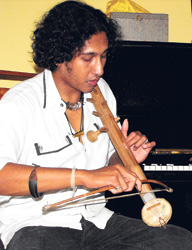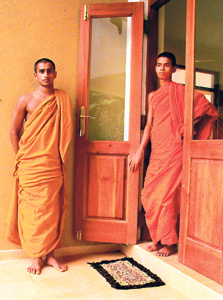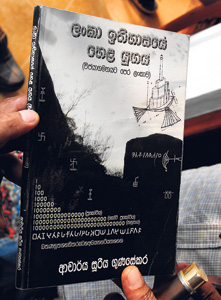| In a tourist emporium in New Delhi I was being hassled by an overzealous sales assistant. I was getting bored with fending him off. “How about a beautiful statue of Ganesh?” he asked, “Or Shiva?”
“Actually, I was rather hoping to find a statue of Ravana,” I said. “You know the guy with ten heads and twenty arms? …from the Ramayana?”
He was visibly taken aback. “No, no, no,” he said, shaking his head, “Ravana is a symbol of evil. Nobody would want a statue of him in their home.”
My tactics worked, and he backed off.
 |
| Dinesh playing the ravanhattha |
I was in India for a four-month period researching a book I am currently writing on an ancient musical instrument called the ravanhattha. Although this instrument – the oldest ancestor of the violin – is used in Rajasthan, northern India, ancient mythology states that it was invented by Ravana, King of Lanka.
The story goes that Ravana, one of the most powerful beings in the universe, objected to his mother’s plan to go and live on Mount Kailash in what is now Tibet. To appease her, he decided to bring the mountain to Sri Lanka. As he lifted up the mountain, Shiva was angered by his arrogance and pushed it back down, trapping Ravana. The King of Lanka tore off one of his own arms and made a musical instrument, ripping out sinews to form the strings. He used the newly invented ravanhattha to sing the praises of Shiva, creating music of such beauty that Shiva wept and forgave him.
It was inevitable that the research for my book would lead me to Sri Lanka. I wanted to get a different angle on the Ravana mythology since I was beginning to feel that the Indian view, as described mainly in Valmiki’s Ramayana, might be a little biased, to say the least.
At the Sadaham Sevana Buddhist centre in Colombo I was welcomed by the Ven Athureliye Rathana Thera, Buddhist monk and politician. I admitted that my knowledge of Buddhism was not great, and the Ven. Athureliye patiently explained that according to ancient Buddhist scriptures, Lord Buddha had been invited to Sri Lanka by none other than Ravana himself.
 |
| Monks at Sadaham Sevana Buddhist centre |
Lord Buddha preached to Ravana, and the resulting Lankavatara Sutra was not only the foundation of Mahayana Buddhism in Sri Lanka, but having been translated into Chinese also became the basis of Chan and Zen Buddhism as well. Could the enlightened Ravana that I read about in the English translation of the Sutra possibly be the very embodiment of evil as described in the Ramayana? On the Hindu festival of Dussehra, effigies of Ravana are burned all over India as a symbol of the triumph of good over evil.
During the few days I spent in Sri Lanka, I uncovered a whole artistic community of young people for whom Ravana is a positive influence and a creative springboard.
The film producer Sanjaya Nirmal informed me that he was engaged in a long-term research project which would culminate in a trilogy of films, like the Lord of the Rings trilogy, about the life (or lives) of Ravana. He believed, he told me, that the many references in historical and mythological texts referred to several avatars, collectively known as Ravana. There were also numerous books on medicine and science which were attributed to Ravana, still available in print, but only in Sinhalese. There was plenty of evidence around, Sanjaya told me, that the historical figure Ravana had presided over a well-ordered and technologically superior nation of contented inhabitants. He had not been the evil despot portrayed by Valmiki.
The following day I vainly scoured the bookshops of Colombo for anything attributed to Ravana that had been translated into English. There was nothing. But one book did catch my eye. The Secret of Ravana: The Golden Era by Dulitha Wijewantha, was written, I discovered, by a fifteen-year-old schoolboy and was aimed at a teenage readership. It had been published at the start of 2009. Such a book would be unthinkable in India, and it was becoming clear that a great disparity existed between Indian and Sri Lankan views of this perhaps as much historical as mythological figure.
 |
Focusing once again on the basis of my research, I had arranged to meet the young Sri Lankan musician Dinesh Subrasinghe. Dinesh has recently been offered the chance to study at the institute of Academy Award winning composer A.R. Rahman (of Slumdog Millionaire fame). We had corresponded and it was clear that we shared a fascination for the ravanhattha. Dinesh is the only musician I have encountered who is attempting to use the instrument in a modern context, and he gave me a copy of his forthcoming CD, Ravan Nada, on which it is used extensively. Dinesh explained that it frustrated him that an instrument invented by the ancient King of Lanka seemed to be so ignored in his home land. But if he had anything to do with it, that was set to change. He had launched a one-man crusade to raise awareness of this neglected aspect of Sri Lankan heritage.
I had hoped to leave Sri Lanka with some appreciation that there were other possible ways to interpret the mythology surrounding Ravana. I had expected to indulgently listen to the unconvincing opinions of people who were trying to re-position a mythological demon as some kind of anti-hero. But I learned that in Sri Lanka, the mythology surrounding Ravana presented in Valmiki’s Ramayana is simply deemed incorrect and irrelevant. There are other mythologies, perhaps not widely known outside of Sri Lanka, but a new generation of creative young people are tapping into them as a source of inspiration.
Heading back to India, I realized that just a week in Sri Lanka had given me a whole new insight into the mythological inventor of the ravanhattha, and a fascinating new angle for my book.
The writer is based in Amsterdam, The Netherlands (patrickjered@live.nl) and his book ‘Finding the Demon’s Fiddle’ should be available in print mid-2010. | 